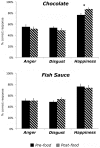Food-Induced Emotional Resonance Improves Emotion Recognition
- PMID: 27973559
- PMCID: PMC5156340
- DOI: 10.1371/journal.pone.0167462
Food-Induced Emotional Resonance Improves Emotion Recognition
Abstract
The effect of food substances on emotional states has been widely investigated, showing, for example, that eating chocolate is able to reduce negative mood. Here, for the first time, we have shown that the consumption of specific food substances is not only able to induce particular emotional states, but more importantly, to facilitate recognition of corresponding emotional facial expressions in others. Participants were asked to perform an emotion recognition task before and after eating either a piece of chocolate or a small amount of fish sauce-which we expected to induce happiness or disgust, respectively. Our results showed that being in a specific emotional state improves recognition of the corresponding emotional facial expression. Indeed, eating chocolate improved recognition of happy faces, while disgusted expressions were more readily recognized after eating fish sauce. In line with the embodied account of emotion understanding, we suggest that people are better at inferring the emotional state of others when their own emotional state resonates with the observed one.
Conflict of interest statement
The authors have declared that no competing interests exist.
Figures



References
-
- Adolphs R. Neural systems for recognizing emotion. Curr Opin Neurobiol. 2002. April;12(2):169–77. - PubMed
-
- Argyle M. Bodily communication. 2nd ed London: Methuen; 1988.
-
- Damasio AR. Descartes’ error: emotion, rationality and the human brain. New York: NY:Grosset/Putnam; 1994.
Publication types
MeSH terms
LinkOut - more resources
Full Text Sources
Other Literature Sources

